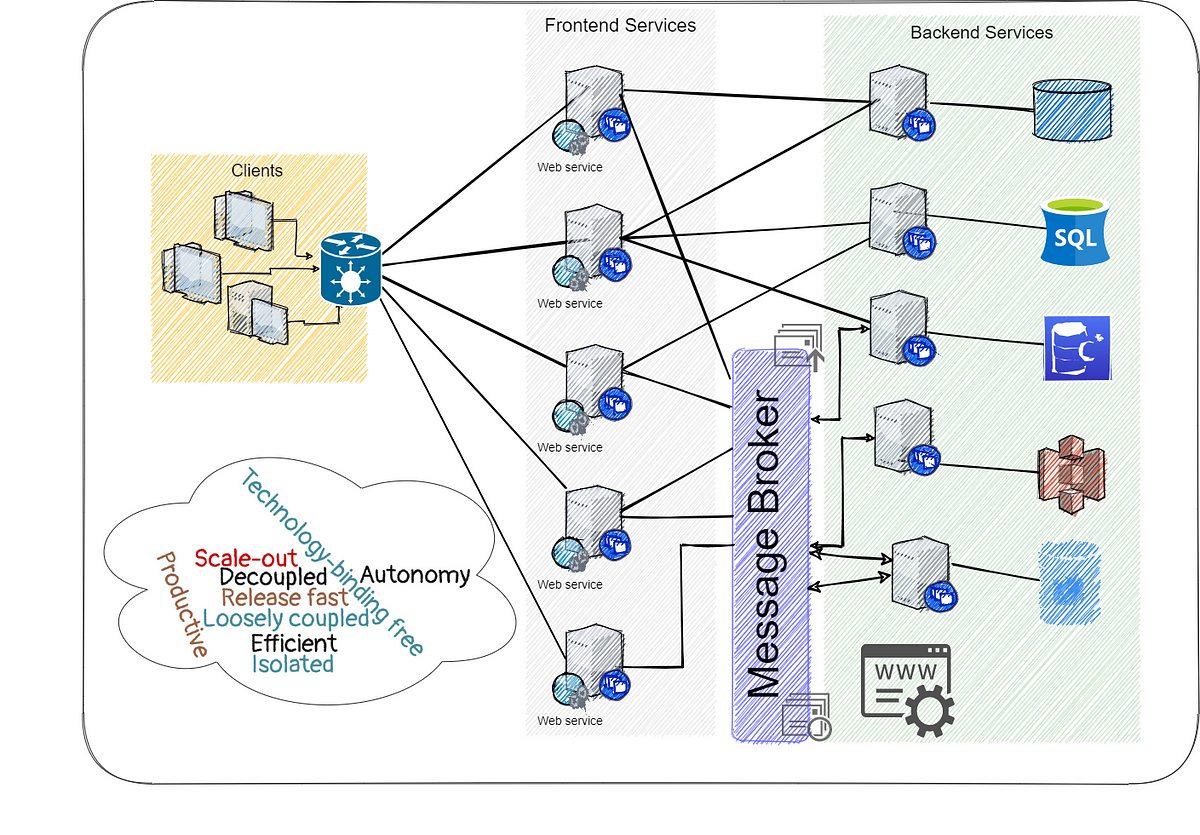Planning a microservices-based application — where to start from? This architecture is composed of many aspects; how to break down this decoupled architecture? This article aims to review the planning and implementation considerations of a microservices-based solution. I hope that after reading this article, the picture will be clearer.

The Gist
- Why?
- The reasoning for choosing microservices.
- What to consider?
- The planning considerations before moving to microservices (versioning, service discovery and registry, transactions, and resourcing)
- How?
- Implementation practices (resilience, communication patterns)
- Who?
- Understanding the data flow (logging, monitoring, and alerting)
Building a viable microservices solution is attributed to the technical platform and supporting tools. This article focuses on the technical foundations and principles, without diving into the underlying tools and products that carry out the solution itself (Docker, Kubernetes or other containers orchestration tool, API Gateway, authentication, etc.).
While writing this article I noticed that each of the parts deserves a dedicated article; nevertheless, I chose to group them all into one article so we can see the forest, and not only the trees
1. The Principles Behind Microservices
In a microservices architecture, a single application is composed of many small services; each service operates on its own process while communicating with other services over the network by some inter-process communication form, which will be discussed in later in Part 3.
This decoupling allows more flexibility, compared to a monolithic application since each service is independent and can be developed, deployed, and maintained regardless of the other services that compose the application.
Microservices characteristics include three main aspects:
- Domain-Driven Design (DDD)
Each service is a separate component that can do only one thing; it is upgradable, regardless of the other services. The service is built to handle a specific domain and declares its boundaries accordingly; these boundaries are exposed as a contract, which technically can be implemented by API. The considerations for decomposing the system to domains can base on data domain (model), business functionality, or the need for atomic and consistent data-transactions.
Not only the technology applies the DDD concepts, but also the development team can adhere to this concept too. Each microservice can be implemented, tested, and deployed by a different team.
- Loose coupling, high cohesion.
Changing one microservice does not impact the other microservices, so altering behaviour in our solution can be done only in one place while leaving the other parts intact. Nevertheless, each service communicates with other services broadly, and the system operates as one cohesive application.
- Continuous delivery
Facilitates the testing on the microservice architecture. By doing extensive use of automation, we gain fast feedback on the quality of the solution. The fast feedback goes throughout the whole SDLC (software development lifecycle). It allows releasing frequently more mature and stable versions.
Why Microservices?
The main objectives to make a transition towards a microservices solution is to be able to develop fast, test easily, and release more frequently. In short, it means shortening the features’ time-to-market while reducing risks. In the monolith world, a change is not isolated from the rest of the application layers. With that, every change may have a huge impact on the system’s stability. Therefore, the agility in the SDLC is affected; releasing a new feature incurs more testing time, prudent releases, and overall prolonged time-to-market.
- **Easy **to develop a small-scale service that focuses only on one main use-case. It is more productive to understand the logic and maintain it.
- Dividing the work between the teams is simpler. Each service can be developed solely by another team.
- Start-up time of each service is faster than a monolith application.
- Scaling-out/in is effective and controlled. Adding more services when the load rises is simple, and similarly, when the load is low, the number of running services can be reduced. With that, utilizing the underlying hardware is more efficient.
- Tackling and troubleshooting can be isolated if the source of the problem is known. After that, resolving the problem is an isolated chirurgical fix.
- Technology-binding is limited to the service level. Each service can be developed in another technology than the others. It allows matchingthe best technology to address the use-case and bypass the constraints of using the same programming language as the rest of the system. Furthermore, it allows using newer technologies; if the system is written in Java (an outdated version), we can add a newer service written in a newer version of Java or even another language, such as Scala.
Microservices — Not Only Benefits
When you have a hammer, everything looks like a nail. This sentence is relevant for a microservice-based solution too. Along with the advantages, there are some drawbacks:
- Understanding and developing a distributes system as a whole is complex. Designing and implementing inter-service communication can involve various protocols and products. This complexity is embedded in each phase of the SDLC, starting from designing until maintaining and monitoring.
- Since each service has one main use-case or domain to manage, developing atomic transactions should be spread into several services (unless designing the microservices based on the data-consistency domain); it is more complicated to implement the transaction and its rollback across several services. The solution should adapt and embrace the eventual consistency concept (described in details later).
- Due to the granularity of services, there might be many requests. It can be inefficient and increase latency. Although there are ways to reduce the number of calls the client sends (see the section about GraphQL), developers might drift and execute inadvertently the logic with more requests than needed.
After reviewing these drawbacks, the next step is to see how to mitigate them as much as possible during the planning and the implementation stages.

Advantages and drawbacks
#software-design #software-development #domain-driven-design #microservice-architecture #microservices
